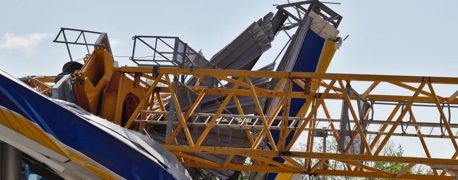New Mexico’s Industrial Accidents Reveal Persistent Safety Gaps
In the Land of Enchantment, tourism is the leading industry. But New Mexico’s economy is heavily reliant on oil and natural gas, as well as manufacturing and high-tech industries, such as weapons and energy research. Dairy mega‑plants, petrochemical processors, and oilfields are scattered from Clovis to the Permian. These facilities churn out milk and cheese, fuel, pharmaceuticals, and thousands of local paychecks—but they also store volatile solvents, high‑pressure gases, and corrosive acids. When maintenance shortcuts or safety lapses occur, the results can be disastrous.
Here, we will take a brief look at three recent industrial workplace accidents and consider what lessons we can learn from them.
Toxic Gas Release at Southwest Cheese in Clovis
On the morning of December 20, 2024, a clean‑in‑place (CIP) line malfunctioned inside the Southwest Cheese plant in Clovis, allowing 8.67 gallons of acid to mix with 0.61 gallons of chlorine—a combination that generated a toxic cloud. Twenty employees working nearby inhaled the fumes; 14 were taken to local hospitals, and 2 were listed in critical condition.
Exposure to chlorine gas can have serious consequences. In low concentrations, it can cause throat, nose, and eye irritation. Higher concentrations of chlorine gas can quickly lead to respiratory distress and pulmonary edema, characterized by an accumulation of liquid in the lungs. Acute exposure can be fatal.
The chemical spill at Southwest Cheese is still under investigation, but mechanical failures can be traced to design or manufacturing defects, inadequate maintenance, or other instances of negligence.
Fatal Oilfield Accident in Malaga
Two workers were servicing wellsite equipment for Mewbourne Oil Company in Eddy County on November 28, 2022, when something went catastrophically wrong.
Deputies were called to the scene at about 9:30 a.m., at which point they found one of the workers deceased; the second worker was air‑lifted to El Paso with extensive injuries that, while serious, were later deemed non‑life‑threatening.
A detective with the Eddy County Sheriff’s Office cited an “industrial accident” as the cause of the death and injury. No fire or vehicle collision was reported, leading investigators to focus on mechanical failure or stored‑energy release (e.g., a pressurized line or stuck valve).
Key Takeaways:
- Isolated sites may experience delayed aid. The nearest EMS unit traveled dozens of miles on US‑285 to reach the site, which is common in remote oilfield locations.
- Historical pattern of oilfield injuries. New Mexico has the second-highest rate of fatal oil and gas extraction injuries in the United States.
- Contractor vulnerability at wellsites. Temporary crews often perform the riskiest maintenance, yet receive the least site‑specific hazard training.
Marathon Petroleum Railcar Fatality in Loving
On May 12, 2020, a 49‑year‑old contract worker from Marshall, Texas, was inspecting a rail tank‑car at Marathon Petroleum’s Loving terminal when he was fatally injured.
OSHA’s fatality log lists the event as a confined‑space accident. The employee was found unresponsive inside the car, which contained residual hydrocarbon vapors. Investigators cited deficiencies in the facility’s entry‑permit system and atmospheric testing.
Key Takeaways:
- Confined‑space complacency: Even brief “look‑and‑see” entries require proper gas monitoring and attendant oversight.
- Corporate reach vs. local oversight: Multinational operators must ensure that remote New Mexico depots meet the same standards as larger stations elsewhere.
Regulatory Oversight in New Mexico: Industrial Accidents
In New Mexico, the Occupational Health and Safety Bureau (OHSB) operates under a state-approved OSHA plan. This includes the adoption of 29 CFR 1910.146, which governs permit-required confined spaces. Employers must implement comprehensive confined space programs, including hazard evaluations, entry permits, atmospheric testing, and rescue procedures. Training is mandatory for all personnel involved in confined space entries, ensuring they understand the hazards and necessary precautions.
Regarding chemical safety, particularly chlorine—a hazardous substance commonly used in various industries—New Mexico adheres to OSHA's permissible exposure limits (PELs). For chlorine, the exposure limit is 0.5 parts per million (ppm) as an 8-hour time-weighted average, with a short-term exposure limit of 1 ppm. Employers are required to monitor air quality and implement engineering controls to maintain exposure levels below these limits. Additionally, the New Mexico Occupational Health and Safety Act mandates that employers maintain Safety Data Sheets for all hazardous chemicals and ensure they are accessible to employees during each work shift.
The OHSB conducts regular inspections and enforces compliance through citations and penalties when violations are identified. They also offer consultation services to assist employers in identifying and correcting potential hazards, promoting a proactive approach to workplace safety.
Lessons & Industry-Wide Implications
Industrial accidents in New Mexico, including those involving confined spaces, toxic exposure, heavy machinery, heights, and the various other hazards workers face, are inexcusable. They cannot be justified as “inherent” when hazard recognition, training, and emergency preparedness can mitigate the risks or eliminate them altogether.
Industries must prioritize the development and implementation of comprehensive safety programs that address the specific risks associated with industrial worksites. This includes regular training, effective communication of hazards, and the establishment of comprehensive emergency response plans—not to mention proper inspection and maintenance of equipment and machinery. Safety protocols should also receive continuous evaluation and improvement to ensure they evolve with changing work environments and emerging hazards.
Accountability & Next Steps
Accountability lies with various parties. Employers are responsible for creating safe work environments, complying with regulations, and supporting a culture of safety at plants and refineries, oilfields, and other industrial job sites. Regulatory agencies, like New Mexico's OHSB, must enforce standards effectively and provide guidance to help employers meet their obligations. Manufacturers must design and produce equipment that is free from defects.
Moving forward, a collaborative approach is essential. Employers should engage with regulatory agencies, industry groups, and workers to share best practices and lessons learned. Investing in safety not only protects workers but also enhances operational efficiency and organizational reputation.
By committing to continuous improvement and accountability, New Mexico's industries can prevent future incidents and ensure the well-being of their workers.
- Categories


